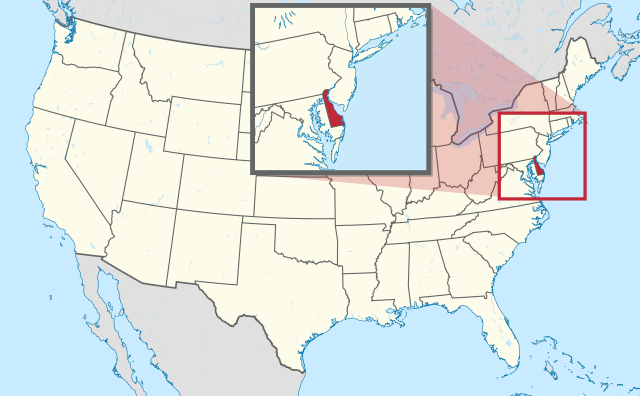Delaware
DELAWARE IS ONE OF the Middle Atlantic states of the UNITED STATES. It is also the country's second smallest state after RHODE ISLAND, covering 2,057 square mi (5,328 square km) within the DELMARVA PENINSULA. It is bordered by MARYLAND on the west and south, NEW JERSEY to the northeast across the Delaware Bay and Delaware River, and there is a short border with PENNSYLVANIA in the north. The state's 783,600 residents (2000) share their part of the peninsula with Eastern Shore Maryland and VIRGINIA. The area is part of the Atlantic Coastal Plain, which runs for more that 2,200 mi (3,667 km) from Cape Cod to the Gulf of Mexico. The countryside is relatively flat, with the land rising gently from sea level in the areas along the eastern shore to 442 ft (135 m) in the Piedmont region along the border with Pennsylvania. The southern part of the state is mostly swampland. A number of small rivers flow across the state, flowing either east to the Delaware (the Christina and Brandywine) or west across Maryland to the Chesapeake Bay (the Nanticoke). The state capitol is in Dover, although Wilmington is the largest city with 72,664 residents.

When Henry Hudson sailed into the Delaware Bay for the Dutch East India Company in 1609, he found the area of sand dunes, swamps, and gently rolling hills inhabited by Native Americans (Nanticoke and Minqua). Although both English and Dutch interests vied for the region, the Dutch established the first settlement in 1631. Within a year, however, that settlement was destroyed by a rare Native American attack. For the most part, the area's Native Americans were friendly and open to trade and within a short time several Dutchman interested in settling the area received permission to colonize the area for Sweden. Peter Minuit, one of the more notable of the early settlers, led the expedition for the Swedes, organizing New Sweden and founding Fort Christina on the site of today's Wilmington in 1638. Following a number of battles among the English, Dutch, and Swedes, the area was finally turned over to England in 1674, where it remained until the American Revolution. The Colony of Delaware became a state in 1776 and was the first state to ratify the new Constitution of the United States in 1787.
By the end of the 18th century industry was making inroads in Delaware. In the Piedmont region of the north with the rolling wooded hills, the Brandywine and Christina rivers provided ideal locations for gristmills to grind grain into flour. At the same time, Wilmington became a center for the manufacture of cloth, paper, and flour products, an industrial sector that flourished into the 19th century. The Du Pont family established a gunpowder mill on the Brandywine River in 1802, marking the beginning of what would become one of America's most successful family business empires.
More recently, the finance and insurance sectors have become increasingly significant employment and income generators, although manufacturing and agriculture are still important. The manufacturing, credit card, banking, and insurance industries are heavily concentrated in the north. Broiler chickens, soybeans, corn, and dairy products comprise the heart of a still vibrant agricultural sector, utilizing lands generally below the Chesapeake and Delaware Canal in the south. Potatoes and other vegetables are also grown; in addition there is a small fishing industry centered on harvests of clams, menhaden, oysters, and scup.
Because Delaware has some of the more lenient laws regulating business taxation and practice, the state is home to many of the largest corporations in the United States. This is especially true for those in the banking and financial services sectors, and these now dominate the state's economy. The chemicals and materials monopoly that was founded by the Du Pont family in the 19th century, despite being broken up by the government in an antitrust suit in 1912 and losing another suit in the 1950s over the firm's major interest in General Motors, continues to be one of the largest corporations in the world. In addition to chemicals and chemical products, the biomedical, apparel, processed foods, rubber and plastic products, and transportation equipment industries are important and contribute to the state's wealth.